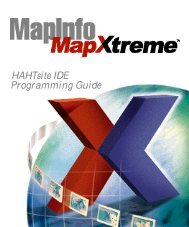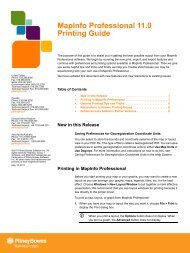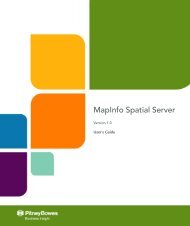MapInfo Spatial Server Web Map Service - Product Documentation ...
MapInfo Spatial Server Web Map Service - Product Documentation ...
MapInfo Spatial Server Web Map Service - Product Documentation ...
Create successful ePaper yourself
Turn your PDF publications into a flip-book with our unique Google optimized e-Paper software.
Overview<br />
Overview<br />
The <strong><strong>Map</strong>Info</strong> <strong>Spatial</strong> <strong>Server</strong> <strong>Web</strong> <strong>Map</strong> <strong>Service</strong> (WMS) allows software clients to reference map images<br />
over the Internet or a private intranet. The WMS implementation is based on the WMS 1.1.1 and 1.3.0<br />
OGC specification. Using HTTP requests, the WMS provides georeferenced data to a client that displays<br />
this data as an image. Georeferenced data is information associated with maps that describe the real<br />
world extents of specific features and the projection upon which it is based.<br />
The images can be provided as GIF, JPEG, PNG, and other image formats.<br />
Layers and Styles<br />
The images rendered can be made of layers that are hierarchical—an image can be served that is made<br />
up of a layer that is a collection of other layers. Since WMS renders layers, the characteristics that<br />
modify the view of layers, such as styles and coordinate systems, can also be included in the layers<br />
provided. This lets you customize images because each image can act as a separate layer within the<br />
client that is accessing these images.<br />
WMS <strong>Server</strong>s<br />
Aside from the servers provided by Pitney Bowes Software Inc. and any service that you provide through<br />
your own organization, there are many public access WMS servers available on the World Wide <strong>Web</strong>.<br />
There are WMS servers for LandSat data, USGS DOQ photos, bathymetry, weather, and many other<br />
data types. Pitney Bowes Software Inc. maintains a <strong>Web</strong> <strong>Map</strong> <strong>Server</strong> of many of our data products. To<br />
view these products, open the following URI in a WMS client, such as <strong><strong>Map</strong>Info</strong> Professional:<br />
http://www.mapinfo.com/miwms<br />
If you are accessing maps from different sources, it is not a complicated task to combine the images into<br />
a single coherent image that your users can work with. It is important to keep the spatial information<br />
(bounding box, spatial reference system, height, and width) identical. This ensures that the different images<br />
align with each other properly.<br />
Note:<br />
Not all <strong>Web</strong> <strong>Map</strong> <strong>Server</strong>s adhere to the OGC standards and may or may not be compatible with<br />
your WMS client.<br />
Please refer to the OGC WMS 1.1.1 or 1.3.0 specifications (www.opengeospatial.org/standards/) for<br />
more information about developing a WMS client to the WMS 1.1.1 or 1.3.0 specification.<br />
Understanding the WMS <strong>Server</strong> Functionality<br />
6<br />
There are three WMS server-specific methods that provide the basis for the server implementation:<br />
• GetCapabilities<br />
• Get<strong>Map</strong><br />
• GetFeatureInfo<br />
Each of these methods is discussed below.<br />
<strong><strong>Map</strong>Info</strong> <strong>Spatial</strong> <strong>Server</strong> 1.0
















